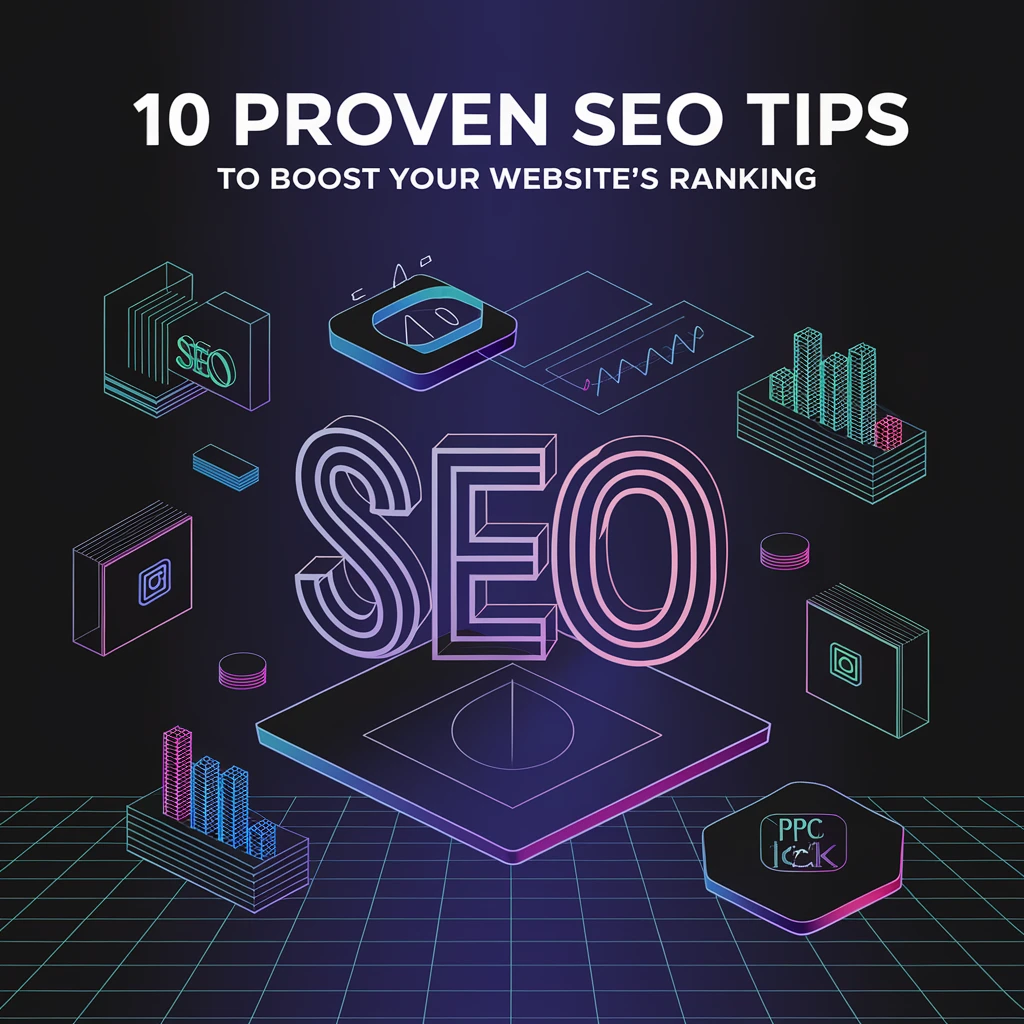In the ever-changing world of digital marketing, SEO (Search Engine Optimization) remains one of the most critical strategies for driving organic traffic to your website. Whether you're a beginner or an experienced marketer, staying updated with SEO best practices is essential. In this post, we’ll dive into 10 proven SEO tips to help you boost your rankings, attract more visitors, and grow your business.
1. Keyword Research: The Foundation of SEO
The backbone of any SEO strategy is keyword research. Understanding which terms your audience is searching for enables you to optimize your content effectively. Aim for a balance between high-traffic and low-competition keywords.
Tools for Keyword Research:
Tool Features Pricing Google Keyword Planner Free, Ideal for Beginners Free SEMrush Advanced keyword and competitor research Paid (from $119/mo) Ahrefs Comprehensive keyword data Paid (from $99/mo)
Here are some best practices for keyword research:
- Target long-tail keywords (e.g., "best SEO tools for beginners") for better conversion rates.
- Use a mix of head keywords (short phrases with high search volume) and body keywords (medium-length phrases with moderate competition).
2. On-Page SEO: Optimizing Every Element
On-page SEO involves optimizing individual pages to rank higher and earn relevant traffic. Here are the most important elements to focus on:
Title Tags and Meta Descriptions:
- Title tags should include your primary keyword and be no longer than 60 characters.
- Meta descriptions should be persuasive and concise, including relevant keywords, to improve click-through rates.
Example of a Well-Optimized Meta Description:
Bad Example Good Example "Learn about SEO tips" "Discover the 10 best SEO tips to boost your website rankings and drive more traffic. Get actionable insights now!"
Other On-Page SEO Essentials:
- Header Tags (H1, H2, H3): Structure your content with headers that include your target keywords.
- Alt Text for Images: Always add descriptive alt text to your images for better accessibility and to improve image rankings.
3. Content is King: Creating Quality, Engaging Content
Search engines prioritize websites that offer valuable, relevant content to users. High-quality content improves user engagement and increases dwell time, which positively impacts rankings.
Here’s how to make your content stand out:
- Long-form content (1,500+ words) tends to rank higher, especially for competitive terms.
- Use visuals, such as images, videos, and infographics, to break up text and make content more engaging.
- Focus on solving user intent, meaning your content should provide clear answers to searchers’ queries.
Content Type Ideal Word Count SEO Benefit Blog Posts 1,500+ words Ranks higher for detailed and in-depth topics Product Pages 500-700 words Better conversions with clear, concise info Landing Pages 500-1,000 words Improved user experience and higher rankings
4. Mobile Optimization: Prioritizing Mobile-First Indexing
As mobile search continues to dominate, Google’s mobile-first indexing has made mobile optimization non-negotiable. If your site isn’t mobile-friendly, your rankings may take a hit.
Here’s what you can do:
- Ensure a responsive design so that your website adjusts to different screen sizes.
- Test your site’s mobile usability with Google’s Mobile-Friendly Test tool.
- Avoid using intrusive pop-ups that frustrate mobile users.
Key Mobile Optimization Metrics:
Metric Importance Page Load Time Faster loading improves user experience and SEO Text Readability Text should be easily readable on small screens Touch-Friendly Navigation Buttons and links should be easy to tap on mobile
5. Page Speed: Faster Sites Rank Higher
Page speed is a direct ranking factor. Websites that load faster provide a better user experience and tend to rank higher on Google.
Ways to Improve Page Speed:
- Compress images and use proper formats (e.g., WebP for web).
- Minimize CSS and JavaScript to reduce code bloat.
- Leverage browser caching to store some data locally for faster access on repeat visits.
You can use Google PageSpeed Insights to evaluate your site’s speed and get suggestions for improvement.
6. Internal Linking: Improve Navigation and SEO
Internal linking helps search engines understand the structure of your site and distribute link authority across your pages. It also makes it easier for users to find related content.
Best Practices for Internal Linking:
- Use descriptive anchor text that includes your target keywords.
- Link from high-authority pages (e.g., popular blog posts) to pages you want to rank higher.
- Ensure a clear hierarchy with important pages receiving more internal links.
Page Type Internal Links Example Blog Post Link to related posts, resources, or services Product Page Link to product reviews, FAQs, or testimonials Service Page Link to case studies, blog posts, or pricing pages
7. Build High-Quality Backlinks: The Power of External Links
Backlinks from authoritative sites act as votes of confidence for your website, signaling to search engines that your content is credible and worth ranking higher.
How to Build Backlinks:
- Guest Posting: Write valuable content for reputable sites in exchange for a backlink.
- Create Shareable Content: Infographics, research reports, and expert roundups attract natural backlinks.
- Competitor Analysis: Use tools like Ahrefs to analyze your competitors’ backlinks and find opportunities.
Backlink Type Impact on SEO High-Authority Backlinks Significantly improve rankings and credibility Niche-Specific Backlinks Boost relevance for specific topics Social Backlinks Drive traffic but have a lesser impact on rankings
8. Technical SEO: Ensuring Your Website is Crawlable
Technical SEO focuses on optimizing the infrastructure of your site, ensuring it’s crawlable and indexable by search engines.
Key aspects of technical SEO include:
- XML Sitemap: Submit a sitemap to Google Search Console to help search engines find your pages.
- Robots.txt File: Use this file to control which parts of your site search engines should crawl.
- Fix Broken Links: Remove or replace any links that lead to 404 errors.
Common Technical SEO Issues to Fix:
Issue How to Fix Slow Page Speed Optimize images, use a CDN, and reduce file sizes Duplicate Content Use canonical tags or 301 redirects Non-Mobile Friendly Site Implement responsive design and test on mobile
9. Enhance User Experience (UX): SEO Beyond Keywords
Search engines prioritize user experience (UX) as a ranking factor. A well-designed, intuitive site increases user engagement and encourages visitors to stay longer.
Ways to Improve UX:
- Clean Navigation: Ensure users can easily find what they’re looking for.
- Readable Text: Use a clear font size and structure paragraphs for readability.
- Engaging Design: Add visuals and interactive elements like polls or quizzes to keep visitors engaged.
User Experience Metrics:
Metric Importance Dwell Time Longer visits improve SEO Bounce Rate High bounce rates can negatively impact rankings Time on Page More time indicates valuable, engaging content
10. Local SEO: Optimize for Local Search
For businesses targeting local audiences, local SEO is essential. Optimizing for local searches can drive more relevant traffic and increase your chances of showing up in Google’s local pack.
Key Local SEO Strategies:
- Claim and optimize your Google My Business listing with accurate details.
- Use location-based keywords (e.g., "digital marketing agency in New York") in your content.
- Encourage customers to leave positive reviews on Google and other platforms.
Start Implementing These SEO Tips Today!
SEO is an ongoing process, but by implementing these 10 proven tips, you can start seeing improvements in your website’s ranking and traffic. Focus on high-quality content, build strong backlinks, and continuously optimize your site’s technical SEO. By doing so, you'll stay ahead of the competition and grow your online presence in the long run.
Remember, SEO success doesn’t happen overnight—it takes patience, consistency, and effort.



0 Comment